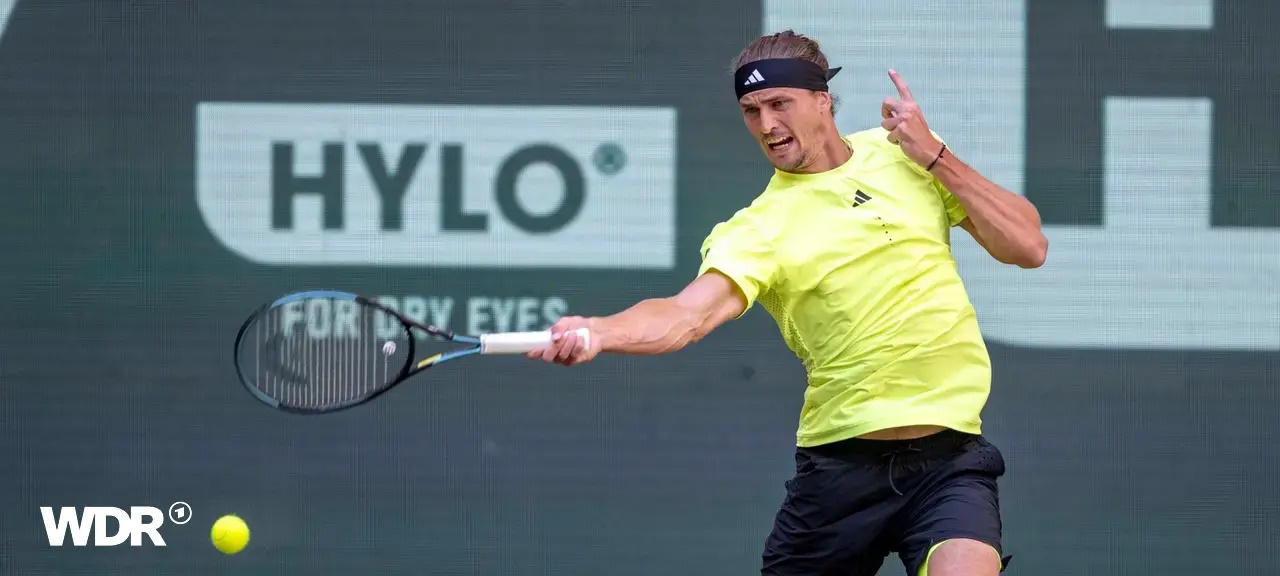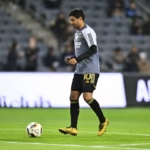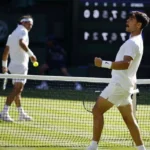The world of professional tennis witnessed a thrilling encounter at the ATP 500 tournament in Halle, Germany, as Alexander Zverev, Germany’s top-ranked male tennis player, fought tooth and nail to secure his spot in the quarterfinals.
His opponent, the tenacious Italian Lorenzo Sonego, pushed Zverev to his absolute limits in a match that stretched over two and a half grueling hours. In a testament to his mental fortitude and sheer willpower, Zverev emerged victorious, prevailing in a tightly contested three-set battle.
This hard-fought win, with a final score of 4:6, 6:4, 7:6 (7:2), not only propels Zverev further into the tournament but also provides invaluable match practice on the grass courts of East Westphalia. This is particularly crucial as he fine-tunes his game in preparation for the prestigious Grand Slam tournament at Wimbledon, scheduled from June 30th to July 13th.
The Halle tournament serves as a key tune-up event, allowing players to adapt their strategies and movements to the unique demands of grass-court tennis. Zverev’s ability to overcome a challenging opponent like Sonego in such a demanding match will undoubtedly bolster his confidence heading into one of the sport’s biggest stages.
Early Stages: A Tentative Beginning
Both players started the match cautiously, struggling to find their rhythm and consistency on the grass court.
Searching for Solidity
The opening stages of the match saw both Alexander Zverev and Lorenzo Sonego exhibiting a somewhat error-prone performance. Neither player managed to establish immediate dominance or unleash a consistent barrage of winners. Instead, the early games were characterized by a mutual search for rhythm and precision. Despite the initial struggles, both players, through sheer effort, managed to win their respective service games, albeit with noticeable difficulty.
This initial period lacked the customary flair and spectacular rallies often associated with high-level professional tennis. Spectators were not treated to dazzling shots or breathtaking exchanges. Instead, both Zverev and Sonego seemed to be in a phase of “searching for their solidity,” attempting to settle into the match, minimize unforced errors, and build a foundational confidence in their groundstrokes and serves. This tentative beginning set the stage for a gradual escalation of intensity as the match progressed.
A Slow Rise in Game Quality
As the first set unfolded, the overall game level only slowly began to improve. Alexander Zverev, known for his powerful groundstrokes, gradually found his range and started to place his formidable forehands with increasing effectiveness. These powerful shots began to trouble Sonego, forcing him to react defensively. However, the Italian, renowned for his fighting spirit and strong serve, consistently found answers to Zverev’s escalating pressure. Sonego’s serve, in particular, proved to be a potent weapon, frequently reaching speeds of 200 km/h (approximately 124 mph) as he drilled it over the net.
This velocity and precision allowed him to hold his own service games with greater conviction, preventing Zverev from gaining an early advantage. Despite Zverev’s improving forehand, Sonego’s reliable serve and resilience in rallies kept the score tight, setting the stage for a pivotal moment in the set. The gradual increase in quality suggested both players were slowly adjusting to the unique characteristics of grass-court play, which demands quick reactions and precise ball striking.
First Set Shift: Sonego Capitalizes on Zverev’s Uncertainty
A sudden dip in Zverev’s serving consistency allowed Sonego to seize control and take the opening set.
Zverev’s Unexpected Instability on Serve
Up to a crucial point in the first set, Alexander Zverev had appeared relatively stable on his serves. His powerful delivery, a cornerstone of his game, had been holding up against Sonego’s returns. However, in the eighth game, with the score standing at 3:4 in favor of Sonego, a sudden and unexpected shift occurred. Zverev began to act “suddenly uncertain” on his serve. This brief but critical lapse saw him commit three consecutive easy errors, an uncharacteristic display for a player of his caliber.
These unforced errors, stemming perhaps from a momentary loss of focus or tactical misjudgment, provided Sonego with a golden opportunity. The Italian, who had overall been acting more courageously and investing more effort into the match, was quick to recognize and capitalize on Zverev’s uncharacteristic vulnerability. This psychological shift in Zverev’s performance at a key moment proved to be the turning point in the opening set.
Sonego Secures the Break and the Set
Seizing the moment, Lorenzo Sonego wasted no time. He immediately converted his very first break point opportunity, moving swiftly to a commanding 5:3 lead. This break of serve, fueled by Zverev’s sudden errors, put Sonego in a dominant position to close out the set. In Sonego’s subsequent service game, Zverev found himself with no chance to respond or mount a comeback.
The Italian continued his confident play, serving with power and precision. Sonego decisively closed out the set with a powerful ace, sealing it 6:4. This emphatic finish to the first set demonstrated Sonego’s mental strength and tactical awareness, as he expertly exploited Zverev’s temporary dip in form. Taking the first set against a top player like Zverev provided Sonego with significant momentum and put the pressure squarely on the German to elevate his game in the ensuing sets.
Second Set Resurgence: Zverev Turns Up the Heat
Frustrated by the first set loss, Zverev elevated his performance and fought back with renewed determination.
Frustration Fuels Zverev’s Fightback
As the second set commenced, Alexander Zverev’s frustration from dropping the first set was palpable. His body language clearly indicated a strong desire to elevate his performance and rectify the situation. He recognized the need for a significant “performance increase” to overcome the deficit. Zverev began the set with a successful and more confident service game, holding his serve efficiently. This immediately put pressure back on Sonego. In Sonego’s very next service game, Zverev quickly carved out two crucial break points.
These opportunities signaled his aggressive intent and his determination to break Sonego’s serve and gain an early advantage. However, Sonego, displaying his own resilience, defended both break points with two consecutive and impressive drop shots, showcasing his touch and ability to stay calm under pressure. Ultimately, the Italian managed to hold his service game, narrowly preventing Zverev from securing an early break. Despite this missed opportunity, Zverev’s heightened intensity was evident, and he was clearly “closer” to making a decisive move in the set.
Zverev’s Breakthrough: A Zero-Point Break
Throughout the middle of the second set, Zverev continued to apply pressure. He consistently won his service games with authority, showing much greater stability and power than in the first set. He progressively managed to put Sonego under more and more pressure, forcing the Italian to work harder for every point.
Despite this, Zverev initially lacked the “final consequence” in his return game, meaning he couldn’t quite find the necessary consistency at a high level to convert his pressure into decisive break opportunities. The rallies became longer and more intense, with both players battling fiercely.
This pattern continued until the score reached 5:4 in favor of Zverev. At this pivotal moment, the German “suddenly turned up his game” to another level. He delivered a stunning performance in Sonego’s service game, achieving a “break to love” (winning the game without Sonego scoring any points). This decisive and emphatic break secured the set for Zverev with a 6:4 score, leveling the match at one set all.
This break not only demonstrated Zverev’s ability to elevate his game under pressure but also shattered Sonego’s confidence on serve, fundamentally shifting the momentum of the match. Zverev’s consistent serving coupled with this late-set surge allowed him to force a deciding third set, setting the stage for a dramatic conclusion.
Deciding Set: A Tie-Break Thriller
The final set saw both players raise their game, culminating in a high-stakes tie-break where Zverev’s mental strength shone through.
Elevating the Game’s Quality
Entering the final set, Zverev noticeably appeared more active and in control, beginning to dictate the flow of the match. His aggressive play and improved consistency meant that Sonego was largely reacting to Zverev’s shots rather than initiating rallies. The German had undeniably achieved a “clear performance increase” compared to the earlier stages of the match, showcasing his elite capabilities. However, Sonego, true to his fighting nature, remained a formidable opponent.
The Italian continued to serve with remarkable consistency, a key factor in keeping Zverev at bay and preventing him from running away with the set. As the match progressed into its decisive phase, the overall quality of the game successively increased, with both players hitting higher quality shots and engaging in more intense rallies. This suggested both were now playing near their peak, making for a truly competitive and thrilling spectacle.
Zverev Dominates the Tie-Break
The final set saw both players largely winning their service games with consistent authority right up to a score of 6:6. There were only minor wobbles on serve, indicating both players were maintaining high levels of focus and precision under immense pressure. With no decisive break achieved by either side, the ultimate decision had to fall to a tie-break, the most nerve-wracking and decisive format in tennis. In the tie-break, Alexander Zverev quickly seized the initiative.
He managed to secure an early “mini-break” (winning a point on Sonego’s serve) to take a crucial 2:1 lead. This early advantage provided him with a significant psychological edge. He then steadily extended his lead to 5:2, demonstrating superior composure and execution in the high-pressure environment of the tie-break. Sonego, despite his best efforts, could not close the gap. Ultimately, Zverev completed his hard-fought victory with a decisive volley, sealing the tie-break 7:2.
This emphatic finish concluded a truly demanding match, showcasing Zverev’s ability to perform under extreme pressure and secure a tough win with sheer determination. His strategic play and mental fortitude in the tie-break were key to overcoming Sonego’s persistent challenge.
Looking Ahead: Wimbledon Preparation
The victory in Halle serves as an important step in Zverev’s preparation for the grass-court Grand Slam.
Gaining Crucial Match Practice
Alexander Zverev’s hard-earned victory over Lorenzo Sonego at the ATP 500 tournament in Halle is far more than just a quarterfinal berth; it is a critical opportunity for him to gather further match practice on the East Westphalian grass courts. Grass-court tennis demands a unique set of skills and adaptations compared to clay or hard courts. The lower bounce, faster pace, and potential for unpredictable deflections require players to adjust their footwork, serve placement, and shot selection.
Playing competitive matches against high-caliber opponents like Sonego allows Zverev to fine-tune these specific aspects of his game. He can test his serve-and-volley tactics, practice his slices, and get accustomed to the faster rhythm of grass-court rallies. This hands-on experience is invaluable, as it helps him to adapt his muscle memory and strategic thinking to the nuances of the surface. Each match provides a chance to identify areas for improvement and solidify his strengths under real tournament pressure, which cannot be replicated in training sessions alone.
Building Confidence for Wimbledon
Beyond mere technical refinement, this tough win significantly contributes to Zverev’s confidence building ahead of the prestigious Grand Slam tournament at Wimbledon. Wimbledon, known as the pinnacle of grass-court tennis, demands not only physical prowess but also immense mental resilience.
Overcoming a resilient opponent like Sonego in a grueling three-set battle, especially after dropping the first set, demonstrates Zverev’s ability to dig deep, problem-solve mid-match, and prevail under pressure. This kind of come-from-behind victory reinforces a player’s self-belief and their capacity to perform at their best when it matters most. Heading into Wimbledon, where every match is a high-stakes affair, having recently navigated such a tight contest will serve as a crucial psychological advantage.
It confirms that his preparation is on track and that he can endure and succeed in the demanding environment of major tournaments. The ability to push through tough moments, as he did against Sonego, is a hallmark of Grand Slam champions, and this win provides a strong foundation for his Wimbledon campaign.
Zverev’s Resilient Path Forward
Alexander Zverev’s arduous victory over Lorenzo Sonego at the ATP Halle 500 tournament underscores his tenacious spirit and commitment to succeed, particularly as he prepares for Wimbledon. Despite a tentative start and an initial setback in the first set, Zverev demonstrated remarkable resilience and an ability to elevate his game under pressure. His powerful forehand improved throughout the match, and his composure in the decisive third-set tie-break secured a well-deserved win.
This hard-fought battle provides Zverev with crucial match practice on grass, allowing him to fine-tune his game for the upcoming Grand Slam. More importantly, it serves as a significant confidence booster, proving his capacity to overcome formidable challenges. As he advances to the quarterfinals in Halle, Zverev’s performance signals his readiness to contend at the highest levels of grass-court tennis, setting an optimistic tone for his Wimbledon campaign.








